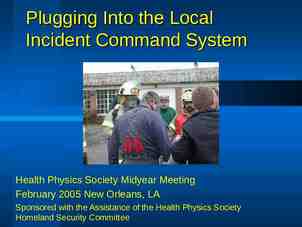+ P What? Katie Endres PA-C
33 Slides3.26 MB

P What? Katie Endres PA-C

Where I started Potomac Falls High School Class of 2004 The College of William and Mary Class of 2008 Bachelors of Science in Neuroscience and Kinesiology Chatham University Class of 2011 Master of Physician Assistant Studies

What is a Physician Assistant? A PA is a nationally certified and state-licensed medical professional PA’s practice medicine with physician supervision in every state, specialty, and setting There are more than 90,000 certified PA’s practicing in the US today

History of Physician Assistant In response to lack of primary care providers after WWII, Dr. Charles Hudson called for “midlevel” providers in the Journal of American Medical Association in 1961 Dr. Eugene Stead developed a program for “physician’s assistant” using former military corpsmen in 1964 In 1965 a Physician assistant educational program was inaugurated at Duke University Program accepted 4 former Navy medical corpsmen

Becoming a PA Prerequisites Healthcare Experience Chemistry Medical Assistant Physiology EMT Anatomy Paramedic Lab Assistant/Phlebotomist Registered Nurse ER Tech Surgical Tech CNA Microbiology Biology GRE/MCAT

Becoming a PA Over 170 Accredited Educational Programs Apply using CASPA Similar to Common Application Programs range from 24 months to 27 months 1st Year-Classroom instruction 2nd Year-Clinical Rotations Graduate with a master’s degree

Becoming a PA Classroom Instruction-1st Year Rotations-2nd Year Anatomy Family Medicine Physiology Internal Medicine Biochemistry Obstetrics and Gynecology Pharmacology Pediatrics General Surgery Emergency Medicine Psychiatry Physical Diagnosis Pathophysiology Microbiology Clinical Laboratory Science Behavioral Science Orthopedics Medical Ethics Cardiology

Becoming Certified Once graduating from an accredited PA program you are eligible to take the PANCE Physician Assistant National Certifying Exam 5-Hour Exam 300 multiple-choice questions To Maintain certification Complete PANRE every 10 years Complete 100 hours of continuing medical education [CME] every 2 years

Becoming Certified CAQ’s Types of CAQ’s Specialty Certificates of Added Qualifications Cardiovascular/Thoracic Surgery To Qualify Emergency Medicine Hospital Medicine Nephrology Orthopedic Surgery Pediatrics Psychiatry 1. 2. Current PA-C certification Possession of a license to practice 3. 2 years of experience 4. 100 hours of specialty specific CME’s 5. Procedures and patient case experience

Physician Assistant Certified Ranked #10 on the Best Jobs List by U.S. News and World Report Median Salary: 92,970 Top 10%: 130,620 Lowest 10%: 62,030 Projected to add 33,300 new positions by the end of the decade 1.2% unemployment rate

Orthopedics Adults Fractures Joint Replacement Shoulder Injuries Rotator Cuff, Labral Tear, Impingment Carpal Tunnel Syndrome Trigger Finger

Orthopedics Total Knee Replacement

Orthopedics Total Hip Replacement

Orthopedics Pediatrics Fractures Scoliosis Sports Related Injuries ACL/PCL Injuries Sprains Strains Hip Dysplasia Clubfoot Cerebral Palsy

Orthopedics Developmental Dislocation of the Hip [DDH]

Orthopedics Tibia Vara Blount’s Disease Growth plate shuts down causing legs to bow outwards 3 Types 1. Infantile [ 3 years old] 2. Juvenile [4-10 years old] 3. Adolescent [ 11 years old] Treatment Non-Surgical-bracing Surgical-osteotomy vs. external fixation

Orthopedics Tibia Vara

Orthopedics Tibia Vara

Orthopedics Leg Length Discrepancy The majority of people in the world have a 2cm leg length discrepancy A limp generally begins when the LLD exceeds 2cm A limp becomes extremely noticeable above 3cm Causes Previous injury to the bone Bone infection Bone diseases

Orthopedics Leg Length Discrepancy

Orthopedics Fractures A partial or complete break in the bone Open vs. Closed Nearly 20% of children who present with an injury have a fracture Growth plate injuries Salter Harris Fracture 5 Types Most common fracture Distal radius Elbow Clavicle Tibia

Orthopedics Fractures Supracondylar Humerus Fracture 10% of all fractures in children Three types Type 1: non-displaced Type 2: displaced Type 3: displaced with no contact of fragments

Orthopedics Fractures

Orthopedics Fractures

Orthopedics Legg-Calve-Perthes Disease

Orthopedics Legg-Calve-Perthes Disease Perthes is characterized by a temporary loss of blood supply to the hip Without blood supply, the rounded head of the femur dies Treatment Non-surgical Petrie casts

Orthopedics Legg-Calve-Perthes Disease Petrie Casts

Orthopedics Legg-Calve-Perthes Disease Surgical Establishes proper alignment of the bones of the hip Head of the femur is placed deep within the socket Alignment kept in place with screws and a plate

Orthopedics Scoliosis An abnormal side-to-side “S” or “C” shaped curve Curve greater than 10 degrees Mainly affects girls Three to five out of every 1,000 children develop spinal curves Three Types Idiopathic: most common Neuromuscular: cerebral palsy Congenital: present at birth, failure of vertebrae to form normally

Orthopedics Scoliosis Signs and Symptoms Uneven shoulder heights Head not centered with the rest of the body Uneven hip heights Uneven shoulder blade heights When bending forward, the left and right sides of the back are asymmetrical

Orthopedics Scoliosis Treatment Observation and monitoring Curves 25 degrees Casting-in young children Bracing Curves 25-50 degrees Surgery Curves 50 degrees

Orthopedics Scoliosis Posterior Instrumentation and Spinal Fusion

Questions? Drag picture to placeholder or click icon to add Drag picture to placeholder or click icon to add






